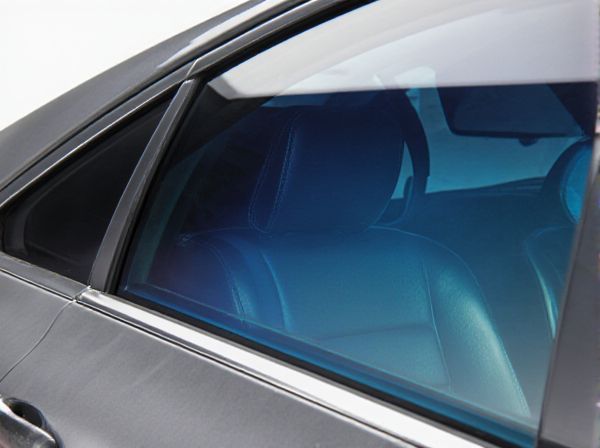
Photo illustration: Ceramic Tint vs Dyed Tint
Ceramic tint offers superior heat rejection and UV protection compared to dyed tint, enhancing your comfort and safeguarding your vehicle's interior. Unlike dyed tint, ceramic tint does not fade or discolor over time, maintaining its clarity and effectiveness. Choosing ceramic tint ensures long-lasting performance and a sleeker, more modern appearance for your windows.
Table of Comparison
| Feature | Ceramic Tint | Dyed Tint |
|---|---|---|
| Heat Rejection | Up to 60% UV and infrared heat blocked | Blocks 35-45% heat |
| UV Protection | Up to 99% UV rays blocked | Approximately 70-80% UV protection |
| Durability | Scratch-resistant and long-lasting | Prone to fading and bubbling over time |
| Visibility | Clearer visibility, less glare | Can darken glass unevenly |
| Cost | Higher upfront price | More affordable initially |
| Installation | Precision installation required | Easy to install |
| Fading Resistance | Resistant to discoloration | Fades faster due to dye breakdown |
Introduction to Window Tinting
Window tinting enhances vehicle comfort and privacy by reducing heat and UV radiation entering through glass surfaces. Ceramic tint uses nanotechnology to block up to 99% of UV rays and significantly reduce heat without interfering with electronic signals. Dyed tint absorbs solar heat and provides basic UV protection but may fade over time and offers less heat rejection compared to ceramic films.
What is Ceramic Tint?
Ceramic tint is a high-performance window film composed of non-metallic ceramic particles that block up to 99% of harmful UV rays and reduce heat effectively without interfering with electronic signals. Its advanced technology offers superior glare reduction and enhanced durability compared to traditional dyed tint, providing long-lasting protection and comfort. This type of tint is favored for maintaining clear visibility while significantly improving energy efficiency in vehicles and buildings.
What is Dyed Tint?
Dyed tint is a car window film made by layering a dyed polyester film that absorbs solar heat and blocks UV rays, reducing glare and interior fading. Unlike ceramic tint, dyed tint does not contain metal or ceramic particles, making it less expensive but also less effective at heat rejection. It provides a sleek, dark appearance but may fade over time compared to the long-lasting durability of ceramic window tint films.
Key Differences: Ceramic vs Dyed Tint
Ceramic tint utilizes nano-ceramic particles that block up to 99% of UV rays and significantly reduce heat, offering superior infrared rejection compared to dyed tint, which primarily relies on carbon or dye layers to absorb light and heat. Unlike dyed tint, ceramic tint does not fade or discolor over time, maintaining clarity and protection for years. The advanced ceramic technology also eliminates signal interference with GPS and mobile devices, a common issue with dyed films.
Heat Rejection Capabilities
Ceramic tint offers superior heat rejection capabilities by blocking up to 60% of infrared rays, significantly reducing interior temperatures compared to dyed tint, which primarily absorbs heat rather than reflecting it. This advanced technology in ceramic films enhances comfort and protects vehicle interiors without compromising visibility or signal reception. Dyed tints are less effective in heat rejection, making ceramic tint the preferred choice for optimal thermal management and energy efficiency.
UV Protection and Health Benefits
Ceramic tint blocks up to 99% of harmful UV rays, significantly reducing skin cancer risks and preventing premature skin aging, while dyed tint offers minimal UV protection primarily by darkening windows. The advanced nano-ceramic particles in ceramic tint provide superior heat rejection and maintain visibility without interfering with electronic signals, promoting eye comfort and reducing glare-related fatigue. Choosing ceramic tint over dyed tint enhances overall health benefits by effectively protecting occupants from UV exposure inside vehicles or buildings.
Glare Reduction and Visibility
Ceramic tint significantly outperforms dyed tint in glare reduction by blocking up to 99% of UV rays and filtering intense sunlight without compromising visibility. Dyed tint relies on a layer of dye that absorbs sunlight but can fade over time and often reduces overall clarity, leading to impaired visibility in low-light conditions. Ceramic tint uses advanced nano-ceramic particles that maintain high visibility while providing superior glare control, making it ideal for safer driving experiences.
Durability and Lifespan Comparison
Ceramic tint offers superior durability compared to dyed tint due to its advanced inorganic nanoparticles that resist fading, bubbling, and discoloration for over 5 to 7 years. Dyed tint typically lasts between 3 to 5 years but is prone to fading and peeling under prolonged UV exposure and high heat conditions. The high heat rejection and UV protection properties of ceramic tint significantly extend its lifespan, making it a more long-lasting investment for automotive and architectural window applications.
Cost Analysis: Ceramic vs Dyed Tint
Ceramic tint typically costs between $200 and $400 for a full vehicle installation, while dyed tint ranges from $100 to $200, making ceramic tint a higher upfront investment. However, ceramic tint offers superior heat rejection and UV protection, potentially reducing energy costs and protecting interior materials longer, which can offset initial expenses. Dyed tint remains a budget-friendly option but lacks the long-term durability and performance benefits of ceramic tint, often requiring more frequent replacements.
Choosing the Right Tint for Your Needs
Ceramic tint offers superior heat rejection and UV protection by using nano-ceramic particles that block up to 99% of UV rays, making it ideal for those seeking long-term comfort and windshield clarity. Dyed tint, while more affordable, primarily provides glare reduction and privacy but lacks advanced heat rejection and fades faster over time. Choose ceramic tint for enhanced durability and performance in sun protection, and opt for dyed tint when budget constraints and basic shading needs are the priority.
 caratoz.com
caratoz.com